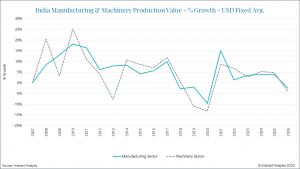Schedule a Call Back
India's potential as a global manufacturing hub
 Industry News
Industry News- Jun 29,22

Following the turbulence caused by the pandemic in 2020, the country saw production time cut by 6 to 8 weeks and lost 16% of its production value compared with 2019. Yet India experienced a relatively strong recovery in 2021. With year-on-year growth of 13.4% taking manufacturing output to just over $1 trillion in 2021, in fact, India became the global leader in manufacturing growth for that year, but much of that was reciprocal pressure as the sector recovered from the steep dip in 2020. We do not expect this recovery to extend into 2022, growth had already flattened out to less than 2% in January and February. We also don’t expect the fact that India is refusing to limit trade with Russia and is indeed in talks with Moscow to boost shipments by $2 billion will be sufficient to counteract the effect of retail inflation and rising crude oil prices caused by the Russia-Ukraine conflict.
According to the WTO, India is the second-largest crude oil importer after China. So we tentatively predict single-digit growth for the Indian industry across 2022 with the non-metallic minerals segment expected to lead the field with a growth of around 6.7%, followed by electronics at 4%. The weak performance is expected for the metals industry, though we only currently have it shrinking by 0.5%. But in April metal producers began cutting production and warned that plants could shut down if the region’s coal shortage continues. This could have serious implications for the country’s economy, as metals are by far India’s biggest industrial sector.
Is China losing its appeal as the go-to region for global manufacturers?
What about speculation that the Indian manufacturing and industrial sector could in the longer-term benefit from a global pivot away from China? What is this rooted in? To get an understanding of this we need first to look at the situation in China. Over the past 20 years, the Chinese communist party has delivered a raft of policies to ensure market reforms supporting state and private enterprises and these have driven spectacular economic growth. But storms have gathered over the Chinese economy: we have seen geopolitical conflict – notably trade wars between China and the US – impacting the Chinese economy, and this has been exacerbated by China’s zero-covid strategy which has meant that lockdowns with their inevitable industrial slowdowns continue to persist even in 2022, disrupting international supply chains.
There have also been many serious blockages in the supply chain. For example, our manufacturing research shows that connectors, wires, plastics, and metal components, including moulds, which have basically never been unavailable before, are currently out of stock at many factories. In April 2022, major connector manufacturers such as Yangtze River and HRS sent out letters to customers informing them of price increases of 10-20%. Of longer-term concern, perhaps, is the government’s newly politicised approach to state capitalism. While the goals are valid – reducing inequality and debt – the means are creating waves as what ‘The Economist’ describes as ‘punitive and erratic’ measures have stifled whole sectors such as the tech industry and the property sector. From a global perspective, the Chinese industrial strategy is presenting a distinctly ideological face, and this is likely not attractive to inward investors, especially when COVID is already in the mix disrupting China-based supply chains.
India – Developing the domestic market is key
Revathi Advaithi, CEO of contract manufacturer Flex, believes the region is poised to become a significant manufacturing hub due to its highly skilled workforce and relatively cheap labour. The company already has six major manufacturing facilities in India. Advaithi envisages India becoming a global player, but before that status is achieved, she says the industry needs to grow and tap into the hugely lucrative domestic market. It’s a case of establishing expansive and resilient supply chains and infrastructure within the country before opening the curtains to the world stage.
Apple builds up operations in India
India is already attracting increased international attention. Sino-American friction, coupled with serious supply chain problems in China has prompted Apple to cast its eye on moving some of the many final assembly operations it has based in China. The Wall Street Journal reports that India has become a major focus for the company, emerging as what the newspaper describes as ‘the company’s top manufacturing target in Asia, outside China. The WSJ’s India-based correspondent Megha Mandavia echoes Revathi Advaithi’s comments when she says India needs to develop a stronger domestic market and logistics infrastructure. She further adds that the country needs more export-friendly policies. Apple appears to be confident the country can deliver. India’s share of the company’s global manufacturing base is forecast to grow from 1.3% in 2021 to between 5% and 7% this year. A significant increase, and a huge vote of confidence from a global company that is highly dependent on smooth production operations.
The long road ahead
India becoming a global manufacturing hub does seem to be on the cards. After all, China did it, as have many South-East Asian countries. But Claudio Knizek of EY Parthenon advises caution. “Several of my clients in industrial sectors are looking for new sources of supply and India is typically on that list. However, many of these companies after their assessment feel that Indian infrastructure is not ready, or that strategically it’s not the right time or the right place and they end up going somewhere else. So, India needs to work on improving the conditions for companies to set up here.”
Author:
Adrian Lloyd is a 20+ year veteran of technology research and has pioneered many data analysis techniques that are used widely by analysts today. He brings his expertise to many technology markets from industrial automation products to semiconductors.
Email: adrian.lloyd@interactanalysis.com
Related Stories

Tariffs are reshaping automation supply chains: Blake Griffin
In this interview, Blake Griffin, Research Manager, Interact Analysis, highlights how trade wars, geopolitical tensions and rare-earth restrictions are reshaping global automation industry.
Read more
Can AI be the game changer for Indian manufacturers?
While manpower issues and quality are driving adoption of industrial automation, cost and lack of knowledge are causing hindrances. Artificial intelligence (AI) can be the game changer, writes Rakes..
Read more
Automation to Drive Packaging Machinery Market Surge
Rising labour costs, regulatory pressures, and the growing influence of e-commerce are driving the demand for end-of-line and warehousing packaging machineries. This growth is reshaping packaging st..
Read moreRelated Products

Digital Colony Counter
Rising Sun Enterprises supplies digital colony counter.
Robotic Welding SPM
Primo Automation Systems Pvt. Ltd. manufactures, supplies and exports robotic welding SPM.

Heat Exchanger Scale Removal Compound -hesr-300
Hi There!
Now get regular updates from IPF Magazine on WhatsApp!
Click on link below, message us with a simple hi, and SAVE our number
You will have subscribed to our Industrial News on Whatsapp! Enjoy















